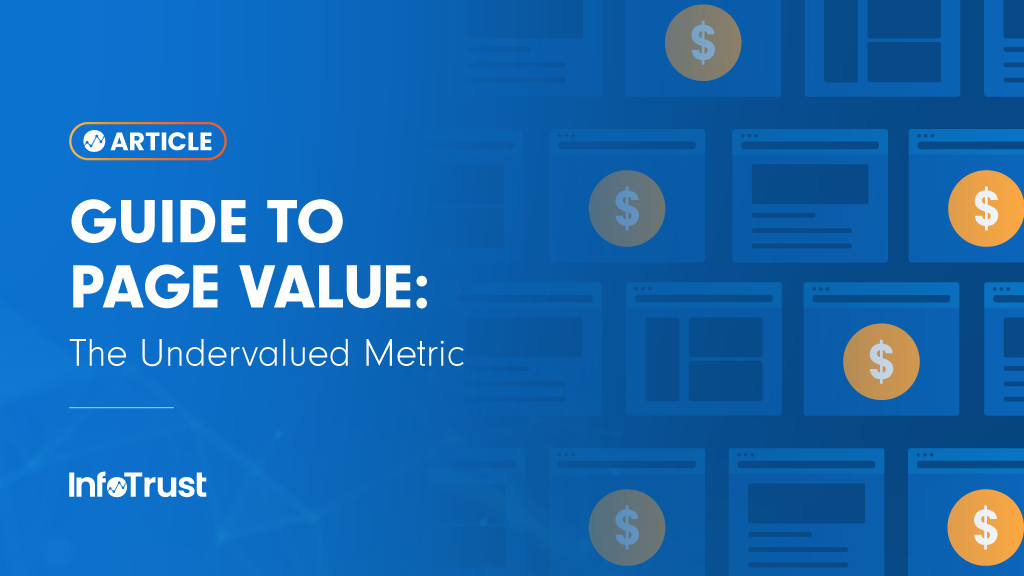Introduction
Data is valuable, wouldn’t you agree? Whether it’s the revenue generated by your business or the number of leads you’ve generated, every slice of data has potential value. While most data wizards focus on the “big guys”—bounce rate, page views, goals, and conversions—the true masters of data take it one step further by mining for another type of statistic: the value of a given web page.
Page value is a metric that can help you understand how valuable each page on your site is for generating revenue and leads. This article explains what page value is, why it’s important to track and measure, and how you can use Google Analytics to create detailed reports to assess your site’s overall performance and uncover opportunities for improvement.
The Metric: Page Value
Page value is the estimated revenue generated by a page.
The metric is calculated using ecommerce revenue, goal page value, and the number of unique pageviews for a given page (per session).
- Ecommerce revenue = transaction total
- Goal page value = the value assigned to a specific page. This value is defined by the business or data wizard when the page goal is configured.
- Unique pageviews per session = each page a user visited during one session. This value is only counted once per session, no matter how many times a user opens that page.
To determine the page value, add ecommerce revenue and goal page value together. Then divide by the number of unique pageviews.
For example, let’s say a user visits four pages before making a purchase of $75. We’ll call those pages A, B, C, and D. You want to measure the page value for page C. Page C has a goal value of $5, and we know the purchase total (revenue) is $75. This user made their purchase within 15 minutes, in only one session. Thus, there was only one pageview value for page C. To calculate, we add revenue ($75) and goal value ($5) for a total of $80. We now divide by pageview for page C (one view). The page value = $80.
Let’s say we have the same scenario as above, but this time the user left and came back three hours later to make their purchase. This resulted in two sessions, each with one pageview for page C. To calculate, we add revenue ($75) and goal value ($5 x two pageviews) = $85. We now divide by pageview (two unique views). The value = $42.5.
Why Is Page Value Important?
Page value is a metric that measures how valuable a page is to your business. It can help you decide which pages are worth investing in and which should be eliminated.
Page value can show a number of things, including:
- What pages are contributing the most to your sales funnel
- How your content is performing
- Which pages are the least influential
Segmented Page Value
Segmented page value can also be used to compare page value metrics between different segments. For example, if you want to see how organic traffic on your site has changed over time and why it changes, segmented page value will help you do that by providing a more accurate view of what’s going on in the real world.
In addition to being able to compare data across different time periods (e.g., monthly vs daily), segmented page value makes it easy for marketers who are interested in getting an overview of their entire website’s performance at once—whether they’re looking at traffic sources or conversion rates or any other metric that involves multiple dimensions such as user demographics and device types/locations.
Google Analytics Page Value Report
The page value report is a list of all the pages on your site. It shows you how much each page contributes to overall revenue, by calculating the value of all transactions that happen on each page and multiplying that by the number of unique visits (pageviews) to that page.
Conclusion
Page value is a useful metric that can give you more insight into which pages on your site are contributing the most to your sales funnel or goals. It’s easy to calculate and should be included as part of your regular analytics reporting, but it also has limitations. Page value only measures one type of engagement from users: how many times they view each page. This means that if someone visits your site five times and sees 10 pages, then all 10 would show up in this report as having equal value—even though some might be more important than others. To avoid this pitfall, try segmenting out just those pages that have “high value” from their peers based on traffic sources like organic search or paid advertising campaigns.





